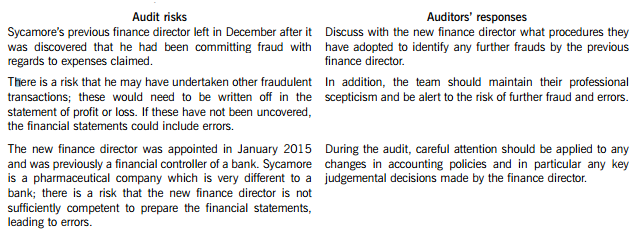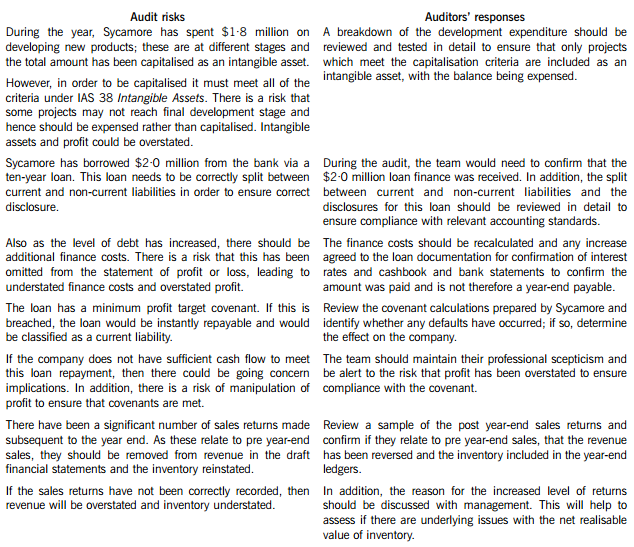2020年ACCA报名条件有年龄方面的限制吗
发布时间:2020-02-23
随着新年的到来,一些准备报考ACCA考试的小伙伴也开始在网上查询相关的报名信息。比如,有网友就在询问2020年ACCA报名条件有年龄方面的限制。鉴于此,51题库考试学习网在下面为大家带来2020年ACCA考试报名条件的相关信息,以供参考。
ACCA考试报名条件较低,在学历达到专科以上的情况下,无年龄要求。如果是专科以下学历,那么则有年龄限制。报名参加ACCA考试,要具备以下条件之一:
1)凡具有教育部承认的大专以上学历,即可报名成为ACCA的正式学员;(教育部承认的学历除了全日制,还包括成考、自考等,请考生注意)
2)教育部认可的高等院校在校生,顺利完成所有课程考试,即可报名成为ACCA的正式学员;(51题库考试学习网提醒:这里的在校生是指本科在校生)
对于学历不满足要求的考生,可通过以下途径报考。
3)未符合以上报名资格的申请者,而年龄在21岁以上,可循成年考生(MSER)途径申请入会。(学历符合要求的考生,没有年龄限制)该途径允许学员作为ACCA校外进修生,在两年内通过F2和F3两门课程,便能以正式学员的身份继续考其他科目。(这种途径进入的考生,在通过F2、F3课程之后,仍然要按照正常考试顺序参加考试)
4)如果是未符合1、2项报名资格的申请者,也可以先申请参加CAT资格考试。考生在获得CAT资格证书后可豁免ACCAF1-F3三门课程的考试,直接进入技能课程的考试。后续考试也是需要正常的模块顺序报名参加的。
各位考生要注意,注册报名随时都可以进行,但注册时间的早晚,决定了第一次参加考试的时间。一般而言,每年7月31日前注册,有资格参加同年12月份的考试;12月15日前注册,有资格参加翌年6月份考试。51题库考试学习网提醒:小伙伴们如果准备不够好,在符合要求的情况下,也别急于报考哦。
以上就是关于ACCA考试报名条件的相关情况。51题库考试学习网提醒:报考ACCA考试需要先注册成为ACCA会员,注册需要将资料寄往英国ACCA总部,需要几周的时间,小伙伴们在报名时要注意。最后,51题库考试学习网预祝准备参加2020年ACCA考试的小伙伴都能顺利通过。
下面小编为大家准备了 ACCA考试 的相关考题,供大家学习参考。
You are the audit supervisor of Maple & Co and are currently planning the audit of an existing client, Sycamore Science Co (Sycamore), whose year end was 30 April 2015. Sycamore is a pharmaceutical company, which manufactures and supplies a wide range of medical supplies. The draft financial statements show revenue of $35·6 million and profit before tax of $5·9 million.
Sycamore’s previous finance director left the company in December 2014 after it was discovered that he had been claiming fraudulent expenses from the company for a significant period of time. A new finance director was appointed in January 2015 who was previously a financial controller of a bank, and she has expressed surprise that Maple & Co had not uncovered the fraud during last year’s audit.
During the year Sycamore has spent $1·8 million on developing several new products. These projects are at different stages of development and the draft financial statements show the full amount of $1·8 million within intangible assets. In order to fund this development, $2·0 million was borrowed from the bank and is due for repayment over a ten-year period. The bank has attached minimum profit targets as part of the loan covenants.
The new finance director has informed the audit partner that since the year end there has been an increased number of sales returns and that in the month of May over $0·5 million of goods sold in April were returned.
Maple & Co attended the year-end inventory count at Sycamore’s warehouse. The auditor present raised concerns that during the count there were movements of goods in and out the warehouse and this process did not seem well controlled.
During the year, a review of plant and equipment in the factory was undertaken and surplus plant was sold, resulting in a profit on disposal of $210,000.
Required:
(a) State Maples & Co’s responsibilities in relation to the prevention and detection of fraud and error. (4 marks)
(b) Describe SIX audit risks, and explain the auditor’s response to each risk, in planning the audit of Sycamore Science Co. (12 marks)
(c) Sycamore’s new finance director has read about review engagements and is interested in the possibility of Maple & Co undertaking these in the future. However, she is unsure how these engagements differ from an external audit and how much assurance would be gained from this type of engagement.
Required:
(i) Explain the purpose of review engagements and how these differ from external audits; and (2 marks)
(ii) Describe the level of assurance provided by external audits and review engagements. (2 marks)
(a) Fraud responsibility
Maple & Co must conduct an audit in accordance with ISA 240 The Auditor’s Responsibilities Relating to Fraud in an Audit of Financial Statements and are responsible for obtaining reasonable assurance that the financial statements taken as a whole are free from material misstatement, whether caused by fraud or error.
In order to fulfil this responsibility, Maple & Co is required to identify and assess the risks of material misstatement of the financial statements due to fraud.
They need to obtain sufficient appropriate audit evidence regarding the assessed risks of material misstatement due to fraud, through designing and implementing appropriate responses. In addition, Maple & Co must respond appropriately to fraud or suspected fraud identified during the audit.
When obtaining reasonable assurance, Maple & Co is responsible for maintaining professional scepticism throughout the audit, considering the potential for management override of controls and recognising the fact that audit procedures which are effective in detecting error may not be effective in detecting fraud.
To ensure that the whole engagement team is aware of the risks and responsibilities for fraud and error, ISAs require that a discussion is held within the team. For members not present at the meeting, Sycamore’s audit engagement partner should determine which matters are to be communicated to them.
(b) Audit risks and auditors’ responses



(c) (i) Review engagements
Review engagements are often undertaken as an alternative to an audit, and involve a practitioner reviewing financial data, such as six-monthly figures. This would involve the practitioner undertaking procedures to state whether anything has come to their attention which causes the practitioner to believe that the financial data is not in accordance with the financial reporting framework.
A review engagement differs to an external audit in that the procedures undertaken are not nearly as comprehensive as those in an audit, with procedures such as analytical review and enquiry used extensively. In addition, the practitioner does not need to comply with ISAs as these only relate to external audits.
(ii) Levels of assurance
The level of assurance provided by audit and review engagements is as follows:
External audit – A high but not absolute level of assurance is provided, this is known as reasonable assurance. This provides comfort that the financial statements present fairly in all material respects (or are true and fair) and are free of material misstatements.
Review engagements – where an opinion is being provided, the practitioner gathers sufficient evidence to be satisfied that the subject matter is plausible; in this case negative assurance is given whereby the practitioner confirms that nothing has come to their attention which indicates that the subject matter contains material misstatements.
(ii) Describe the claim of each of the four identified stakeholders. (4 marks)
(ii) Stakeholder claims
Four external stakeholders in the case and their claims are as follows.
The client, i.e. the government of the East Asian country. This stakeholder wants the project completed to budget and
on time. It may also be concerned to minimise negative publicity in respect of the construction of the dam and the
possible negative environmental consequences.
Stop-the-dam, the vocal and well organised pressure group. This stakeholder wants the project stopped completely,
seemingly and slightly paradoxically, for environmental and social footprint reasons.
First Nation, the indigenous people group currently resident on the land behind the dam that would be flooded after its
construction. This stakeholder also wants the project stopped so they can continue to live on and farm the land.
The banks (identified as a single group). These seem happy to lend to the project and will want it to proceed so they
make a return on their loans commensurate with the risk of the loan. They do not want to be publicly identified as being
associated with the Giant Dam Project.
Shareholders. The shareholders have the right to have their investment in the company managed in such a way as to
maximise the value of their shareholding. The shareholders seek projects providing positive NPVs within the normal
constraints of sound risk management.
Tutorial note: only four stakeholders need to be identified. Marks will be given for up to four relevant stakeholders
only.
(ii) Explain the income tax (IT), national insurance (NIC) and capital gains tax (CGT) implications arising on
the grant to and exercise by an employee of an option to buy shares in an unapproved share option
scheme and on the subsequent sale of these shares. State clearly how these would apply in Henry’s
case. (8 marks)
(ii) Exercising of share options
The share option is not part of an approved scheme, and will not therefore enjoy the benefits of such a scheme. There
are three events with tax consequences – grant, exercise and sale.
Grant. If shares or options over shares are sold or granted at less than market value, an income tax charge can arise on
the difference between the price paid and the market value. [Weight v Salmon]. In addition, if options can be exercised
more than 10 years after the date of the grant, an employment income charge can arise. This is based on the market
value at the date of grant less the grant and exercise priced.
In Henry’s case, the options were issued with an exercise price equal to the then market value, and cannot be exercised
more than 10 years from the grant. No income tax charge therefore arises on grant.
Exercise. On exercise, the individual pays the agreed amount in return for a number of shares in the company. The price
paid is compared with the open market value at that time, and if less, the difference is charged to income tax. National
insurance also applies, and the company has to pay Class 1 NIC. If the company and shareholder agree, the national
insurance can be passed onto the individual, and the liability becomes a deductible expense in calculating the income
tax charge.
In Henry’s case on exercise, the difference between market value (£14) and the price paid (£1) per share will be taxed
as income. Therefore, £130,000 (10,000 x (£14 – £1)) will be taxed as income. In addition, national insurance will
be chargeable on the company at 12·8% (£16,640) and on Henry at the rate of 1% (£1,300).
Sale. The base cost of the shares is taken to be the market value at the time of exercise. On the sale of the shares, any
gain or loss arising falls under the capital gains tax rules, and CGT will be payable on any gain. Business asset taper
relief will be available as the company is an unquoted trading company, but the relief will only run from the time that
the share options are exercised – i.e. from the time when the shares were acquired.
In Henry’s case, the sale of the shares will immediately follow the exercise of the option (6 days later). The sale proceeds
and the market value at the time of exercise are likely to be similar; thus little to no gain is likely to arise.
声明:本文内容由互联网用户自发贡献自行上传,本网站不拥有所有权,未作人工编辑处理,也不承担相关法律责任。如果您发现有涉嫌版权的内容,欢迎发送邮件至:contact@51tk.com 进行举报,并提供相关证据,工作人员会在5个工作日内联系你,一经查实,本站将立刻删除涉嫌侵权内容。
- 2020-01-10
- 2019-12-29
- 2020-01-10
- 2021-08-21
- 2020-01-09
- 2020-01-09
- 2020-02-23
- 2020-02-28
- 2020-01-07
- 2020-01-09
- 2020-01-09
- 2019-01-06
- 2020-01-09
- 2020-02-13
- 2020-01-10
- 2020-01-10
- 2020-02-23
- 2020-01-10
- 2019-01-17
- 2019-01-06
- 2020-01-10
- 2020-02-28
- 2020-01-10
- 2021-06-27
- 2019-01-06
- 2020-01-03
- 2020-02-26
- 2020-02-26
- 2020-01-07
- 2020-01-10